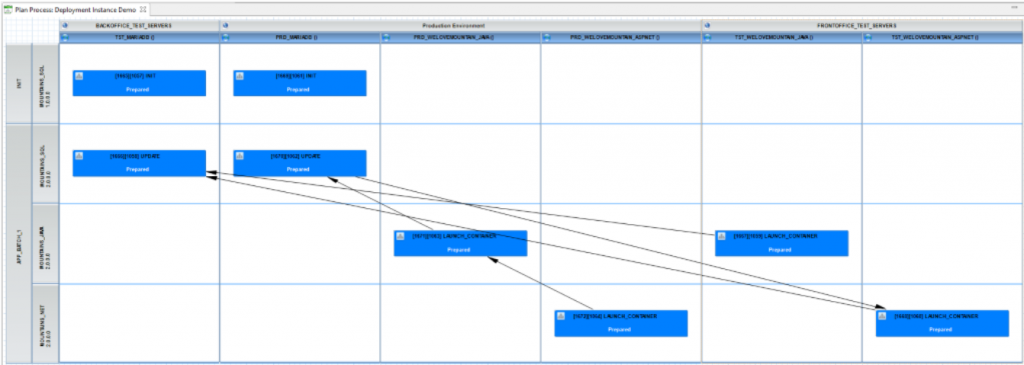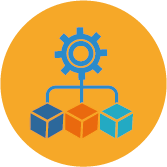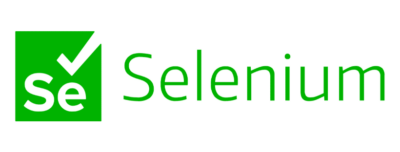Annecy, 10-11-2020 – ARCAD Software, international ISV specializing in DevOps and Modernization solutions, today announced new V4.2 release of its flagship DROPS product for Application Release Orchestration. The new release firmly establishes DROPS as leader in large-scale multi-tier IT environments consisting of a legacy application core with modern service-oriented development. In particular, a new DROPS ‘Release Plans” feature automates the coordination of mixed technology deployments, giving release managers a global, end-to-end view of software deployment and a high-level deployment workflow over time. Further, new environment provisioning features provide full support of hybrid/multi-cloud architectures spanning Microsoft Azure, Google Cloud, AWS and IBM Cloud.
Deployment workflow at application level
DROPS has the major advantage of operating at the ‘application level’, as compared to standard tools such as Jenkins and Ansible which are limited to a simple deployment of artefacts. Philippe Magne, ARCAD CEO explains the principal differentiator with DROPS: “We have designed the Release Plans feature in DROPS specifically for ‘high application availability’. When we start talking about DROPS, the most common reaction is “we already have Jenkins (or Ansible) in that field”. This is why we always need to explain that DROPS is not going against those technologies. It is just a step above. DROPS works in terms of Applications, Environments and Releases and its value is to ensure the consistency and synchronization of deployments based on the interdependencies between application releases. DROPS is really the “Ops” tool in a DevOps toolchain. Its main users are people from the production teams”.
 Application Deployment Workflow using DROPS Release Plans
Application Deployment Workflow using DROPS Release Plans
Global view of deployment status
Marc Dallas, VP R&D at ARCAD Software explains the importance of the new version: “In response to the rise in cloud adoption worldwide, we have made the Release Plans feature the highest priority in our new DROPS version. We are catering the needs of those customers running business-critical systems for which the cost of failure is prohibitively high. Now, DROPS users can plan the deployment of one or several interlinked applications onto a predefined series of environments, such as QA, training, pre-production, production. Users gain real-time visibility over the status of multiple business applications across all environments from test to production, whatever the mix of target platforms, legacy or open, on premise or multi-cloud.”
Hybrid multi-cloud support & dependency management
In order to secure the reliability of the information system overall, DROPS deploys by application or application group, abstracting the notion of platform. Release Plans can be customized to model the specific IT organization and constraints, streamlining the hand-offs between development stages. Application interdependencies and inter-environment transfers are managed automatically to guard against service outages in production.
“With the new version of DROPS, users can pilot and control all application releases with one single solution, across Windows, Linux, any flavor of UNIX, IBM i (aka iSeries AS/400), Kubernetes, containers and cloud-based apps. From DROPS, it is now easy to create on-demand hybrid multi-cloud environments comprising diverse platforms and technologies and deploy them in-sync within seconds”, added Dallas.
Automated rollback
A key strength of DROPS has always been its automated ‘rollback’ feature which can return an application to its previous state, across all platforms and infrastructures. Dallas commented: “After an incident in production, it’s vital to keep any service outage to a minimum. With DROPS, once a defect has been detected, DROPS can rollback both software and data, in sync. The process is 100% automated – no more need to provide custom rollback scripts or manually stop the database to make a backup or snapshot. That is a massive gain both in time and security for any organization”.
Bimodal support: legacy and service-oriented architectures
Dallas highlights the challenges in multi-tier development today: “Some of our customers operate on a continuous delivery model with very frequent application updates, some even on every code commit. In a modern microservices architecture this mode of operation is desirable and reduces the risk of incident in production. However, many customers still run part of their business on legacy applications, which are constrained by the sheer volume and sometimes monolithic areas of code. These ‘systems of record’ have a massive transaction throughput and a high cost of failure. Here software delivery timelines are much longer and application updates must pass through a series of test environments and validations before reaching production. This creates a ‘bimodal’ environment where modern and legacy code are interdependent but deployed at different frequencies. We have designed DROPS release plans to manage these dependencies automatically, orchestrating a continuous value stream from business owner to end-user, with release visibility and control across all teams, technologies and tools”.
Automated database upgrades
To go further in securing application reliability in production, DROPS also manages database upgrades as part of the deployment process. From the same DROPS interface, users can automate the upgrade and rollback for all databases, including ORACLE, DB2 for i, and SQL server.
Open RESTful API & multi-language support
Speaking on the multi-cloud support on DROPS, Dallas added: “With DROPS we have sought to avoid any ‘vendor lock-in’ which has been a common complaint with standard orchestration tools. We have designed DROPS as an open system, with RESTful API enabling integration with enterprise tooling such as Git, Jenkins and Jira, and also any environment provisioning tool such as Terraform, Ansible, Puppet and Chef. We also have embraced external containerization tools such as Docker and Kubernetes to offer maximum infrastructure flexibility to our customers. And finally, we have insisted on multi-language support so that DROPS users can extend functionality with any language of their choice: Javascript, Python, Ruby, Groovy and more”.
Key features in this new DROPS release include:
- Continuous Integration and Delivery (CI/CD) of both software and data
- 100% automated rollback
- Multi-platform and multi-cloud support
- DevOps for Data
- Templatization features and Environments on Demand
- Release Plans and Deployment Workflow
- Multi-language support
- Integration with external containerization and environment provisioning tools
For more information about Application Release Orchestration with DROPS, download the datasheet.
ARCAD Software
55, rue Adrastée
F-74650 Chavanod/Annecy
Press contact: Olenka Van Schendel ovanschendel@arcadsoftware.com

























